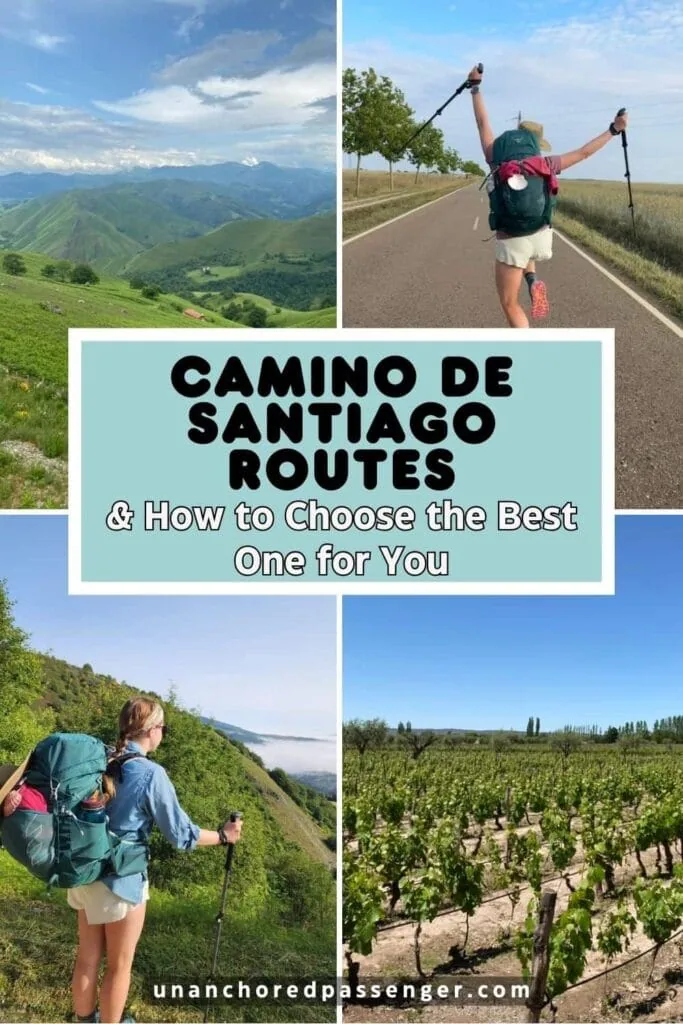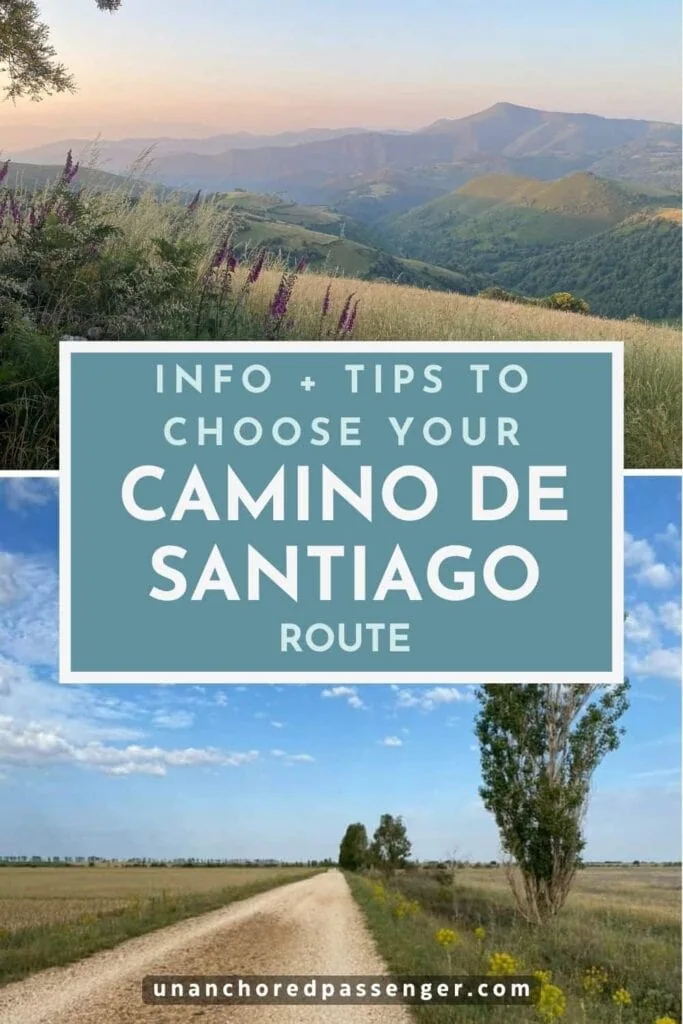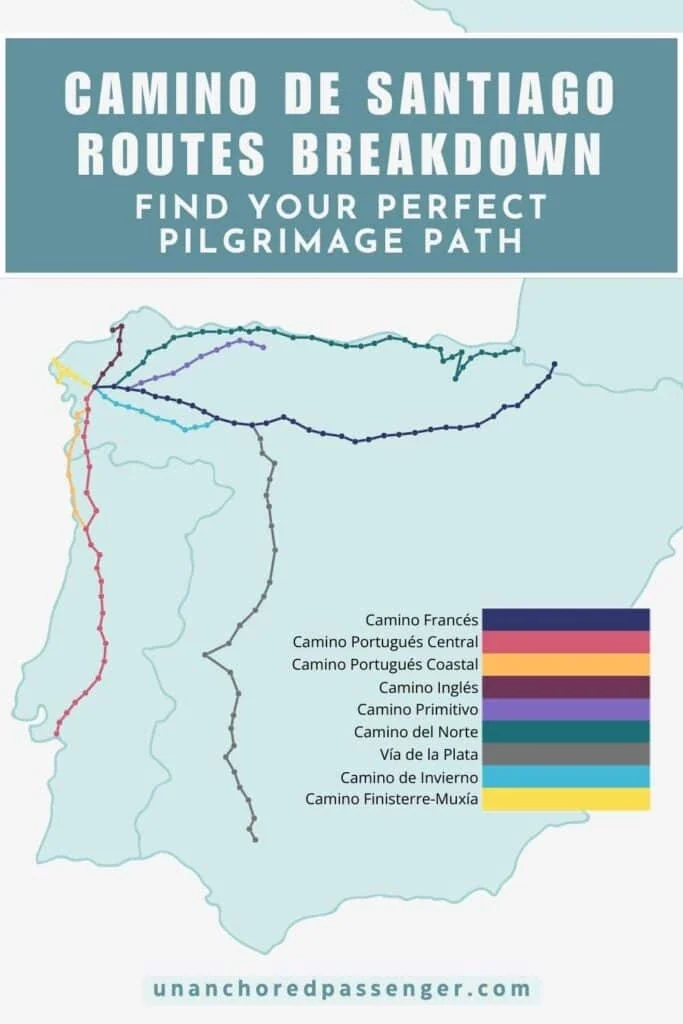Camino de Santiago Routes and Quiz to Help You Choose
While the Camino is often talked about as if it's one experience, there are actually many Camino de Santiago routes to choose from. All embody the spirit of this epic pilgrimage, but each trail provides its own unique adventure.
If you're anything like me, you've decided by now that you want to hike the Camino but are feeling a little lost when you realized it's not just one route… Which route along the Way of Saint James is the best? Which should you hike for your Camino?
I've been in your shoes. I've personally hiked three Camino routes now–the full Francés, the Camino Portugués Central from Porto, and the Camino Portugués Coastal from Porto. Each time I've struggled a bit trying to decide which to choose, but now that I've done the three most popular routes, I'm confident in helping you decide which is right for you.
That's why I've written this piece to help give you information on the various trails that make up the Camino de Santiago. Not only will you find information on each route based on my experiences and other pilgrims, but you'll also find tips and even a quiz to help you choose your route.
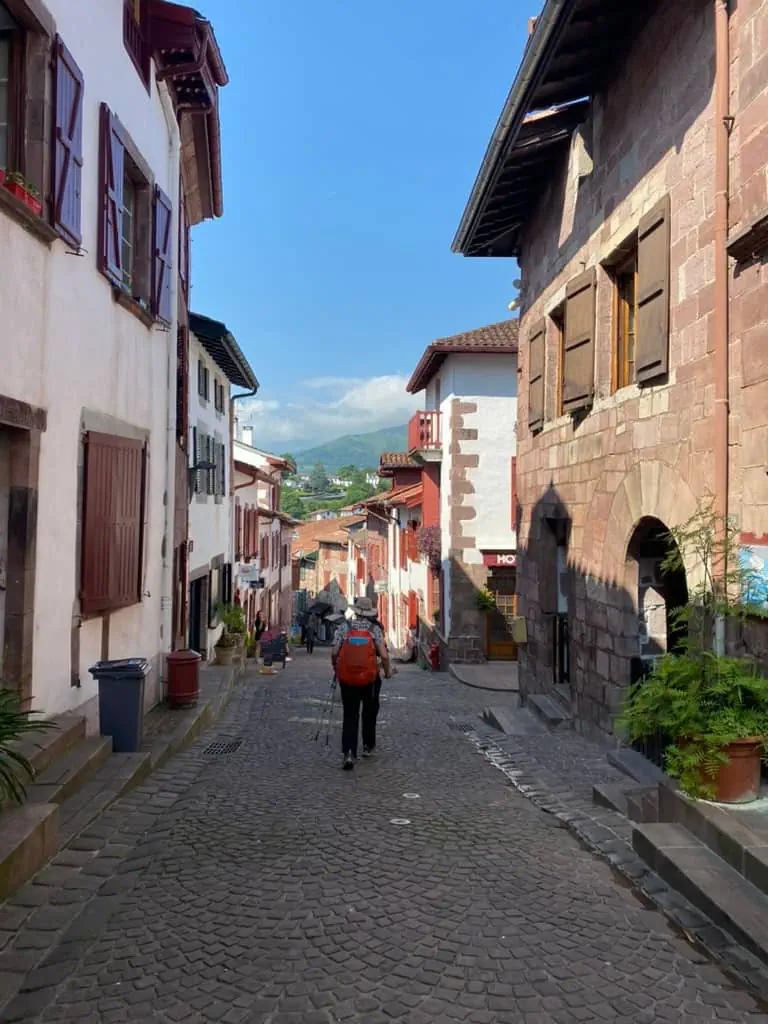
Why Are There So Many Camino de Santiago Routes?
In the Middle Ages, pilgrims would start this pilgrimage from their homes all over the continent. This led to the development of multiple routes depending on where pilgrims were coming from.
Camino de Santiago Routes Map
Before we dive into the details on each trail, here's a map to give you an overview of some of the most popular Camino de Santiago routes. You'll see these routes span multiple countries and regions. Each has something unique to offer, so keep reading to learn more.

Quiz: Which Camino de Santiago Route is Right for You?
Before we dive into details on the Camino de Santiago routes, take this to understand which route might be a good fit for you. This is just meant to be a starting point to get you thinking, so keep reading to learn more.
Camino de Santiago Route Quiz
Answer a few quick questions and I’ll suggest the route that best fits your goals.
How much time do you want to walk?
Have you hiked the Camino before?
How difficult of a route are you comfortable hiking?
How much social time do you want on your walk?
What kind of scenery do you prefer?
How rural or urban of an environment are you hoping to walk through?
When it comes to infrastructure, which would you prefer?
How important is the religious aspect on your Camino?
Note: I am always working to test and improve this quiz, so if you have feedback or suggestions, don't hesitate to reach out at mikala [at] unanchoredpassenger.com.
Best Camino de Santiago Route for First-Time Hikers
The best Camino de Santiago route can vary from person to person depending on your reason for hiking and the experience you're looking for. However, many people recommend the Camino Francés, also known as the French Way, for those hiking the Camino for the first time.
The Camino Francés has been the most popular Camino route for centuries. Because of this, there's a solid infrastructure of places to stay and eat along the way. The route is well marked and is one of the best routes for making friends.
Easiest Camino de Santiago Route
The Camino Portugués route, also known as the Portuguese Way, is considered one of the easiest paths on the Camino de Santiago with its generally flat terrain. There are two main routes that make up the Camino Portugués (more on that below), and each is considered to be fairly easy compared to the other routes.
Note that the Camino is still a challenging journey no matter which route you choose, so don't mistake this for being a walk in the park. There's still some elevation gain and loss on the Portuguese routes, and walking day after day can be hard on your body.
Click here to jump down for more about the Camino Portugués.

Shortest Camino de Santiago Routes
At just 75 miles (120 km), the Camino Inglés, also known as the English Way, is the shortest Camino de Santiago route. The Camino Portugués (from Porto), Camino Primitivo, and Camino de Invierno are shorter as well and can be completed in around two weeks or less.
Many pilgrims with less time choose to hike a shorter version of the Camino Francés, starting in Sarria. From there, it's about 71 miles (115 km) to Santiago de Compostela and typically takes a week or less to complete.

Main Camino de Santiago Routes
Now let's dive into the details on each of the main routes. I've listed the top Camino routes in order of popularity below, based on the latest statistics from the Pilgrim's Office. The Pilgrim's Office tracks all of these routes, recording data on pilgrims who finish them each year.
You'll see I've included rough distances and time to complete each route. Note that distances can vary based on the exact route taken.
Along the routes, you'll find there are sometimes multiple trail options, even if you end up at the same place by the end of the day. This is why you'll see slight variations in distances across sources.
I've also included my estimation of the terrain difficulty based on my experiences and research. I've marked the flattest routes as “easy,” but that does not mean the journey itself is necessarily easy.
Even if the terrain is less challenging, it's important to understand what the day-to-day is like on the Camino and do what you need to prepare yourself ahead of time.
If you prefer video formats, I really like this one by Nadine Walks. She runs through the Camino Francés, Camino Portugués, Camino del Norte, and the Camino Primitivo. You can click to play the video directly below:

Camino Francés (French Way)
Full Distance: 485 Miles (780 km)*
Average Time to Complete: 30-35 Days*
Terrain Difficulty: Moderate
*Beginning at the official starting point of Saint-Jean-Pied-de-Port, France; from Sarria, Spain, the route is 72 miles (115 km) and takes about 5-7 days
Each year, close to half of pilgrims who complete the Camino de Santiago do so via the Camino Francés. UNESCO designated the route a World Heritage Site along with some of the other northern routes.
Since its establishment in the 11th century, the French Way has been the most popular route on the Camino. Back then, it was easier to hike than the other first established routes. In addition, the monarchy and church at the time focused on building infrastructure and protecting pilgrims along the Francés.
The Camino Francés was perfect for my first Camino. It provided the classic Camino experience as a route centered around pilgrims, offered so many opportunities to make friends, and was easy to navigate.
Mikala
The route officially starts in Saint-Jean-Pied-de-Port, France on the edge of the Pyrenees Mountains. Pilgrims who start there get to see such a variety of stunning landscapes in northern Spain.
This was my first Camino in June 2023. I'll never forget crossing over the Pyrenees Mountains, trekking through winery after winery, enduring the hot and flat Meseta, and then taking in the magical green forests of Galicia.
As pilgrims continue along the Camino Francés, they find that much of the route involves passing through small towns and cities that only exist because of the Camino. There's something special about taking part in this journey like millions before you that's so centered around the Camino.
With its popularity over the years, the trail is steeped in history with many churches and other sights to see along the way. With that comes interesting stories and legends of miracles tied to the Camino.

Since it's so popular and historic, the Camino Francés has a strong infrastructure built up around the trail. That means there are many accommodations along the way and no shortage of food options.
Having such a strong infrastructure makes it easier to stay flexible and not have to worry about doing much planning in advance.
When I hiked the Camino Francés in 2023, I found it easy to make stops throughout the day while hiking. I'd often stop for breakfast, lunch, and at least one or two more times for the sports drink Aquarius.
There were only a few days throughout my entire 33-day journey on the Camino Francés where stops were more limited and I had to ensure I carried enough water and snacks with me in case.

While the full Camino Francés route typically takes about one month to complete from Saint-Jean-Pied-de-Port, many people who don't have that much time will start elsewhere along the route. Sarria is a popular starting point, but you can start anywhere.
In the end, I personally found my experience on the Camino Francés to be exactly what I was hoping for and would recommend it to anyone.
I made friends from all over the world, enjoyed spending time in both nature and important Spanish cities, and had a great adventure. I also felt quite safe the whole time, even though I was hiking solo.
Camino Francés Guidebook
I used this guidebook for my Camino Francés and really appreciated the maps and information on stops throughout my journey. If you plan to hike the Francés, I recommend you buy this book. The print version is quite light and easy to carry, but it's also is available on Kindle.
➡️ Check Out + Buy the Book Here
➡️ For a Shorter Version Starting in Sarria, Check Out This Book

Camino Portugués Central (Central Portuguese Way)
Full Distance: 151 Miles (243 km)*
Average Time to Complete: 10-14 Days*
Terrain Difficulty: Easy
*Beginning at the most popular starting point of Porto, Portugal; from Lisbon, Portugal, the route is 384 miles (618 km) and takes about 25-30 days
The Camino Portugués Central is the second most popular Camino route with 95,453 pilgrims having completed it in 2024. Of the two main Portuguese routes, this is the more traditional route with a stronger history and culture around the Camino de Santiago.
This trail offers more mountain views and walks through tranquil villages compared to the Coastal route. It's has more elevation gain and loss than the Coastal route but is still fairly easy in comparison to the other Camino routes. However, some pilgrims find the cobblestones along this route to be one of the most challenging parts.
You can start the Camino Portugués as far south as Lisbon, Portugal, but most pilgrims start in Porto, Portugal. Before Porto, the route is not necessarily as scenic, can pose more difficulties in finding accommodations, and has few pilgrims.
I made one friend on my Camino who told me that the stretch from Lisbon to Porto was his favorite part of the Camino Portugués, but most pilgrims seem to feel the opposite.
If you choose to start from Lisbon, you'll want to take some more time to plan and prepare in advance. From Porto, the Camino Portugués offers many accommodation options and opportunities to meet others, so you don't have to worry as much about researching in advance.
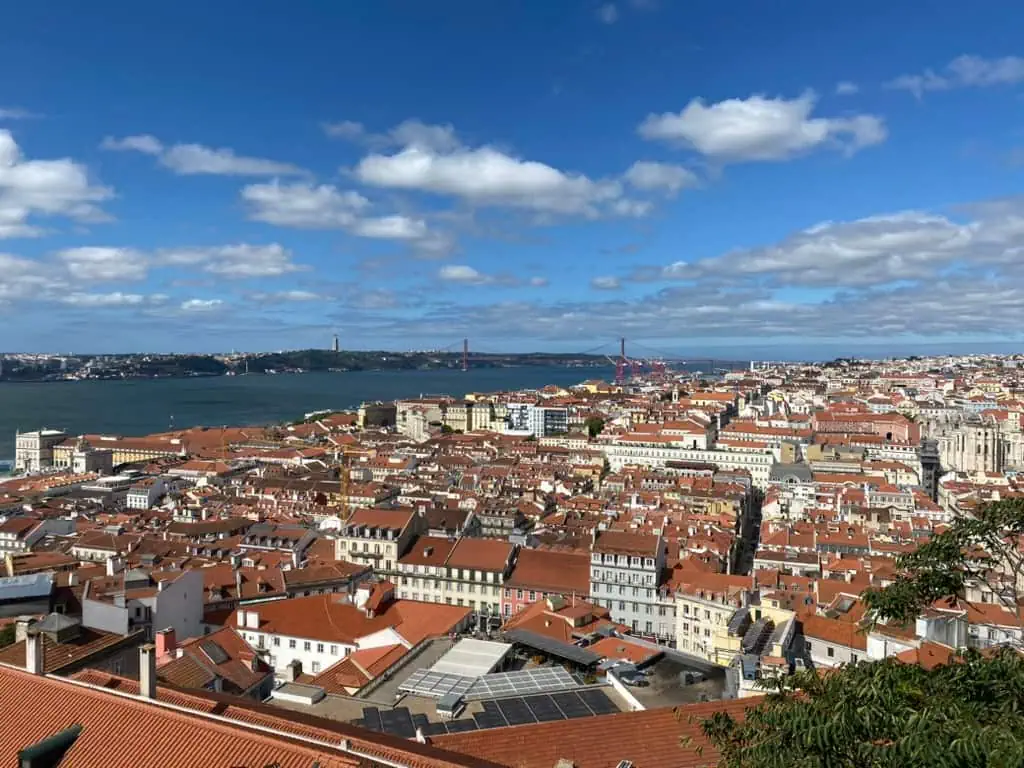
While the Camino Portugués Central is quite popular and somewhat of a social trail, it can be slightly harder to meet other people compared to the Francés.
I made one close friend when I hiked this route from Porto in May 2025. While I met other pilgrims who I connected with, I often didn't see them again, likely because a lot of people switch between the two Portuguese routes so I lost some folks as I continued on the same route.
Of course, another main difference of the Camino Portugués is that some of the way runs through Portugal. If you find yourself drawn more to Portugal than Spain, then this route may be the one for you.
If you choose to hike the Camino Portugués, consider the Spiritual Variant after you reach Pontevedra, Spain. Legend has it that this is the way Saint James's body was brought by boat into Galicia.
I took the Spiritual Variant myself and found it the perfect way to beat the crowds for most of the last 100 km of the Camino. The scenery was spectacular as well.
If you choose to hike this route, PLEASE eat as many pasteis de natas as you can for me! They're a delicious egg custard pastry unique to Portugal and a must try when in the country.
Camino Portugués Guidebook
This guidebook dives into the various Camino Portugués routes, providing maps and information on what to expect. I used this guidebook for my Portuguese Caminos and highly recommend it!
➡️ Check Out + Buy the Book Here

Camino Portugués Coastal (Coastal Portuguese Way)
Full Distance: 170 Miles (274 km)*
Average Time to Complete: 12-15 Days*
Terrain Difficulty: Easy
*Beginning at the most popular starting point of Porto, Portugal; from Lisbon, Portugal, the route is 403 miles (648 km) and takes about 27-31 days
The Camino Portugués Coastal has been rising in popularity in recent years more than any other Camino route. 74,758 pilgrims completed this route in 2024, a jump in over 40% compared to the year prior.
Compared to the Central, the Coastal route is flatter and offers ocean views throughout much of the journey. It also runs through more built up towns and cities compared to the Coastal route.
I walked this route in May 2025 and found myself constantly in awe of the scenery. I've rarely seen such vibrant blue green waters and powerful waves.
I had no doubt when choosing my Camino route. My love for Portugal and the ocean made the Coastal Portuguese route the natural choice. While I didn't have the luxury of unlimited time, I still wanted to experience the full journey–and the 280 km path from Porto to Santiago de Compostela over 12 days was exactly that. In the end, the Camino gave me everything I was looking for: ocean, waves, and peace.
Mariya from Kazakhstan but living in the united arab emirates
The route starts in Porto and generally follows the coastline but isn't always right along the coast. However, pilgrims taking this route can often choose to more closely follow the Portuguese coastline every so often via the Senda Litoral (Litoral Way).
In fact, most pilgrims on this route choose to start their Camino from Porto along the Senda Litoral before joining the Coastal route. I went that way myself out of Porto and loved it. You leave the city by walking along the river until you meet the coast. It's a spectacular way to kick off your hike!
The Coastal route often runs through popular beach towns, so it's less oriented around the Camino and can be slightly more expensive than the Central route. It's said to be a little less social than the Central route; however, its gaining popularity suggests you can still meet other pilgrims along the way.
When I hiked this route, I surprisingly found it to be more social than the Central route, but that very well may have been just because of the people I was walking with.

Portugal's coast tends to have milder weather, so if you're hiking during a warmer month, that's something to consider. Sometimes pilgrims start on the Central route, find it too hot, and switch to the Coastal route.
If you're torn between the Central and Coastal routes of the Camino Portugués, know that you could try both! Many pilgrims start on the Coastal route from Porto and then switch to the Central route. It's possible to zig zag between the two routes throughout your journey, depending on what you want to see.
Eventually, the Coastal route joins the Central route at Redondela, Spain. From there, pilgrims follow the Central route all the way to Santiago de Compostela. There's also the option of taking the Spiritual Variant just north of Pontevedra.
Camino Portugués Guidebook
I highly recommend this guidebook for all the Portugués routes. It goes into details on all your options to help you understand what to expect and which way might be best for you.
➡️ Check Out + Buy the Book Here

Camino Inglés (English Way)
Full Distance: 75 Miles (120 km)*
Average Time to Complete: 4-6 Days*
Terrain Difficulty: Moderate
*Beginning at the more popular official starting point of Ferrol, Spain
The Camino Inglés got its name as it was historically a popular route among northern Europeans who traveled to the Iberian Peninsula via boat. This Camino route is the shortest, running entirely through Spain's autonomous community of Galicia.
This Camino is known for offering a quieter experience with fewer crowds than other routes while still providing pilgrims a mix of time spent hiking through rural areas and quaint villages. That said, it's gaining popularity with 28,058 pilgrims completing this route in 2024.
While it's short, many find the Camino Inglés to have some challenging days of elevation gain. At least temperatures tend to be more mild on the route, but it rains here more often than on some of the other routes.
Pilgrims typically start the Camino Inglés in Ferrol, Spain; however, some start in A Coruña. Those wishing to get a Compostela certificate at the end of their journey should start in Ferrol as the journey from A Coruña is too short to qualify.
Camino Inglés Guidebook
Consider purchasing this guidebook for your Camino. I used a guidebook from the same author for my Camino Francés and found it incredibly helpful in navigating the trail and getting helpful information on each stop along the way.
➡️ Check Out + Buy the Book Here
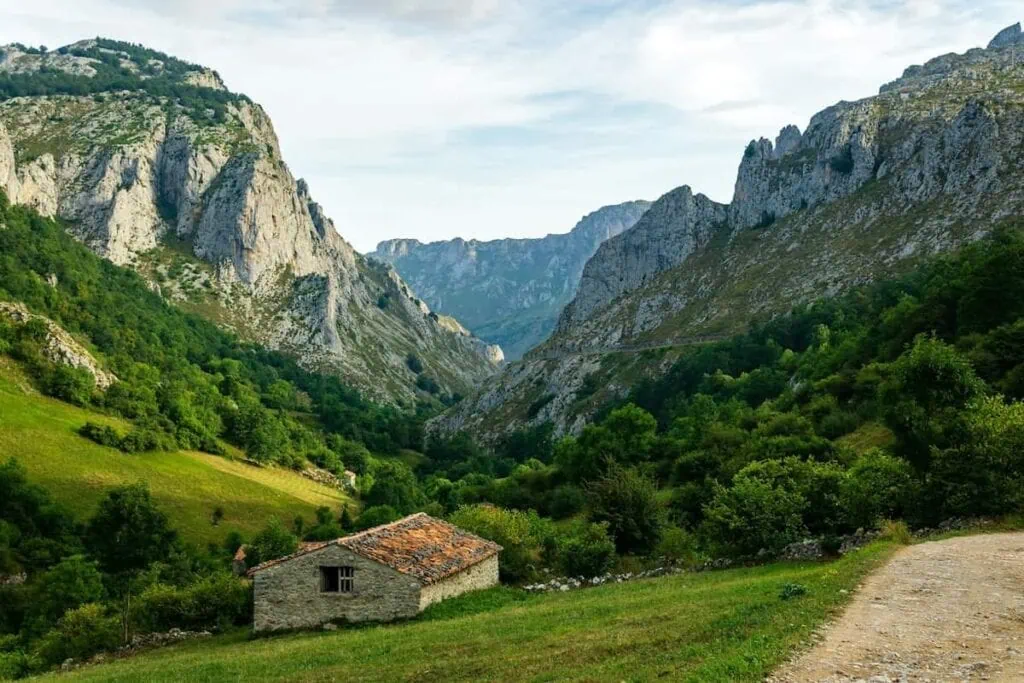
Camino Primitivo (Primitive Way or Original Way)
Full Distance: 199 Miles (320 km)*
Average Time to Complete: 12-15 Days*
Terrain Difficulty: Challenging
*Beginning at the official starting point of Oviedo, Spain
The Camino Primitivo is considered to be the very first Camino route. King Alfonso II of Asturias was the first pilgrim to travel the route in the early 11th century.
The route is known for its stunning mountain views and for being one of the most challenging Way of Saint James routes. There are challenging climbs and no flat days.
Accommodations and food options are further apart than other routes, so if you hike the Primitivo, make sure to do some research on stops in advance and plan accordingly.
24,463 pilgrims completed the Camino Primitivo in 2024. It's not as busy as some of the other Camino routes, but you can still make friends with other pilgrims along the way if you're looking to do so. From what I've read, the route offers a nice blend of being able to hike alone but getting to know other pilgrims in the evenings.
The last few days of the Camino Primitivo meet up with the Camino Francés, so you can still experience a taste of what that trail is like.
I haven't yet hiked the Camino Primitivo, but I plan to hike it along with the Camino del Norte hopefully in the next year or so. Asturias, where this Camino starts, is considered by many to be the most beautiful part of Spain, and I want to see it!
Camino Primitivo Guidebook
Consider buying this guidebook for the Camino Primitivo. The book provides maps for each day, accommodation lists, and information on each town.
➡️ Check Out + Buy the Book Here

Camino del Norte (Northern Way)
Full Distance: 513 Miles (825 km)*
Average Time to Complete: 33-45 Days*
Terrain Difficulty: Challenging
*Beginning at the official starting point of Irún, Spain
The Camino del Norte is one of the most beautiful Camino de Santiago routes. Starting in Irún, Spain, in Basque Country, the route runs close to the northern Spanish coastline. Throughout the journey, you can expect both mountain and coastal views.
This Camino tends to be a quieter and more solitary Camino than the Camino Francés. Just 21,417 pilgrims completed the route in 2024. You can still meet other pilgrims along the way, but don't expect to necessarily find a “Camino family” that you hike with day after day like the Francés.
In terms of difficulty, the Camino del Norte is one of the most challenging Camino routes with lots of ups and downs. Weather is cooler, but the route tends to have a bit more rain than some of the others.
The Camino del Norte runs through many popular vacation cities and towns along Spain's northern coast, which can make it more difficult to find accommodations. If you hike this route during summer, I recommend being mindful of this and making more bookings in advance. With vacationers in town, this route can also be more expensive.

Given this route runs through many vacation towns, pilgrims find that the stops along the way often don't cater to pilgrims as much as on other Camino routes. This means that you may not find early breakfast options available, may need to eat dinners a bit later, and might find food to be more expensive.
While this route has some challenges compared to other routes, many find it well worth it for the views. It might just take a little more planning and watching your budget if you're tight on money.
I'll add that those who hike the Camino del Norte have the opportunity to hike the Camino Primitivo as well. Once you reach Gijón on the Camino del Norte, it's fairly easy to get to the nearby city of Oviedo to start the Camino Primitivo.
I've always wanted to see more of Spain's northern coast so highly considered this for my first Camino. I studied abroad in Spain, and my host mom always said that Asturias–where both the Norte and Primitivo run through–is the most beautiful part in all of Spain.
I ultimately chose the Camino Francés for my first Camino because I wanted a more social experience and wanted to see what the classic Camino de Santiago was like. However, the Camino del Norte is at the top of my list once I find the time to do it.
Camino del Norte Guidebook
I recommend buying this guidebook for the Camino del Norte. The book includes detailed maps, accommodation recommendations, and information on stops along the way. It also includes the Camino Primitivo route for those who want to finish their Camino on that trail instead of continuing on via the Norte.
➡️ Check Out + Buy the Book Here

Vía de la Plata (Silver Way)
Full Distance: 621 Miles (1,000 km)*
Average Time to Complete: 35-50 Days*
Terrain Difficulty: Easy
*Beginning at the official starting point of Sevilla, Spain
As one of the most solitary routes, the Vía de la Plata saw just 9,028 pilgrims in 2024. I met a German guy hiking this route who told me he only saw four people on it until he got to the Camino Francés to continue on to Santiago de Compostela.
This Camino starts in Sevilla, Spain–my favorite place in the world–and travels up through Andalucía, Extremadura, Castilla y León, and Galicia. The route runs through a mix of small villages and towns and important Spanish cities.
While the terrain of this route is considered easy because it's mostly flat, the Vía de la Plata is one of the most challenging Camino de Santiago routes. If you've ever been in southern Spain in the summer, then you know just how miserably HOT it can get.
It's also one of the longest Caminos in terms of total distance and with the distance required on some individual days. Unlike many other Camino routes, you will likely have to walk each day with limited breaks and will need to plan accordingly with food and water.
If you choose to hike this route, spend plenty of time researching and planning your stages beforehand. If this is your first Camino, I'd caution against choosing this route unless you have done many other multi-day hikes before.
Note that while some choose to finish their journeys along the Camino Francés, this route can be completed via the Camino Sanabrés (Sanabres Way) as an alternative. Many prefer that option as it can be a shock switching from the more solitary Vía de la Plata to the busier Camino Francés.
Vía de la Plata Guidebook
For the Vía de la Plata, I recommend purchasing this guidebook. It provides information on hiking this route and then onto Santiago de Compostela via the Camino Sanabrés or the Camino Francés.
➡️ Check Out + Buy the Book Here

Camino de Invierno (Winter Way)
Full Distance: 163 Miles (263 km)*
Average Time to Complete: 10-15 Days*
Terrain Difficulty: Moderate
*Beginning at the official starting point of Ponferrada, Spain
The Camino de Invierno was born out of the need for pilgrims to avoid the mountains during winter months. In spite of the name, know that it's possible to walk this trail year-round.
Those who choose to hike this Camino route appreciate the solitude and time in nature it provides. Few pilgrims hike this route–just 2,870 in 2024–so it's popular among those looking to avoid crowds on the Francés.
Many people say the Camino de Invierno route is what the Camino Francés was like before it became so popular like it is today.
Similar to some of the other less crowded routes, the Camino de Invierno has fewer stops along the way. This means long days of hiking and few, if any, stops throughout the day. Do your research in advance and plan accordingly with this in mind.
Because of those long days (and elevation changes), some consider this to be one of the hardest Caminos.
While this route deviates from the Camino Francés, it starts on the Francés in one of my favorite stops from my Camino–Ponferrada, Spain. Make sure to visit the Knight's Templar Castle there that was built in the Middle Ages to protect pilgrims passing through.
Camino de Invierno Guidebook
Consider purchasing this guidebook for the Camino de Invierno. I used a guidebook from the same author for my Camino Francés and found it so helpful in guiding me through my journey and understanding important historical and cultural sights on the way.
➡️ Check Out + Buy the Book Here

Camino Finisterre-Muxía (Finisterra-Muxia Way)
Full Distance: 74 Miles (119 km)*
Average Time to Complete: 4-7 Days*
Terrain Difficulty: Moderate
*For travel to Finisterre, Spain and on to Muxía, Spain, but you don't have to visit both
The Camino Finisterre-Muxía is the only route on this list that starts in Santiago de Compostela. Most pilgrims add this on following the completion of their initial Camino route.
With this route, pilgrims finish their journeys at the sea. You can choose to travel to either Finisterre or Muxía, or both.
Most pilgrims choose to hike to Finisterre as Romans once believed it was the end of the world. In fact, the name Finisterre comes from Latin finis terra, which means “end of the Earth.”
In both Finisterre and Muxía, you can get unique pilgrim certificates.
Hotel O Semaforo
For a special stay in Finisterre, consider booking Hotel O Semaforo, a hotel in the town's lighthouse.
➡️ Get Hotel Info + Book Here
If you don't have time to add this on to your Camino, you can easily visit either town on a day trip by bus from Santiago de Compostela.
I personally did not have time to add this on to my own Camino, but I hope to hike it on a future Camino. I've heard it can feel slightly anticlimactic after the big finish in Santiago de Compostela, but it's a nice way to continue the journey a little longer.
I also love the idea of literally walking across the entirety of Spain–from crossing over the Pyrenees Mountains on the Camino Francés to ending at the ocean in Finisterre or Muxía.
Camino Finisterre-Muxía Guidebook
This guidebook provides maps and details on the way from Santiago de Compostela to Finisterre and on to Muxía. I really like this guidebook author and trust anything they publish.
➡️ Check Out + Buy the Book Here

Lesser Known Camino de Santiago Routes
There are so many lesser known Camino de Santiago routes all over the world. Here's a list of some lesser known routes and a video by Cole Prosser that talks through some of them.
Some of these routes are officially recognized by the Pilgrim's Office (as indicated with an asterisk), but many are not.
- Camino del Barbanza* (The Barbanza Way): Follows the alleged route Saint James's remains took into Galicia, starting in Ribeira, Spain.
- Geira e Arrieiros*: A challenging route starting in Braga, Portugal.
- Muros-Noia*: Can be completed on foot or via a mix of foot and boat starting in Muros, Spain.
- Camino del Mar* (Way of the Sea): Follows the coastline starting in Ribadeo, Spain and ending in Ferrol or in Neda, Spain. From there, it's possible to pick up the Camino Inglés to continue on to Santiago de Compostela.
- Vía Céltica* (Celtic Camino): Starting in Ireland and finishing in Spain, following the Camino Inglés route from A Coruña, Spain.
- Miñoto Ribeiro*: One of the oldest Portuguese routes starting in Braga, Portugal.
- San Rosendo*: Follows the historic pilgrimage of Elisabeth of Aragon, Queen Consort of Portugal, starting in Braga, Portugal and heading northwest before joining the Vía de la Plata.
- Camino de Le Puy: The most popular Camino route in France, starting in Le Puy-en-Velay, France and ending at Saint-Jean-Pied-de-Port, France, where the Camino Francés begins.
- Camino de Gran Canaria: Camino route crossing through Gran Canaria, the largest island in Spain's Canary Islands.
- San Salvador: Links the Camino Francés at León, Spain with the Camino Primitivo in Oviedo, Spain.
- Camino de Madrid: Runs from Madrid, Spain and joins with the Camino Francés at Sahagún, Spain.
- Camino Mozárabe: Connects the southern coastal cities of Málaga and Almería, Spain with the Vía de la Plata at Mérida, Spain.
- Camino Aragónes: Crosses over the Pyrenees Mountains from Somport, France to Jaca, Spain before traveling to Puente de la Reina, Spain to join the Camino Francés.
- Camino del Ebro: Follows Saint James's alleged journey through Spain to preach the gospel in Galicia, starting in Deltebre, Spain and joining the Camino Francés in Logroño, Spain.
- Camino Levante: Follows the route medieval pilgrims from the Middle East would take starting in Valencia, Spain and connecting to the Vía de la Plata in Zamora, Spain.
*Indicates lesser-known routes officially recorded and recognized by the Pilgrim's Office
Tips for Choosing a Camino de Santiago Route
A lot of factors go into choosing a Camino de Santiago route. Here are some tips I recommend as you consider which route is best for you.
Start by Thinking Through How Much Time You Have
Knowing how much time you anticipate needing will be critical to determining your plans. For instance, if you only have two weeks to hike, you may want to choose one of the Camino Portugués routes or you could hike the Camino Francés starting from somewhere like León.

Consider How Much You Will Be Able to Hike Each Day
As you think about the time you have, consider how much you will physically be able to hike each day. Many of the guidebooks and hiking plans include long days on the trail. Depending on your level of fitness, you may want to break up your hikes into shorter days and add more time to your hike.
For instance, I averaged about 15 miles (24 km) per day on my hiking days on the Francés. I had 8 days where I hiked more than 17 miles (27 km). These were quite long days, and even then it took me 33 days (including one rest day) to finish the full French Way.
If I wasn't as physically fit as I had been, I would have likely needed more time to complete my Camino because having so many long days was absolutely brutal. I found it very challenging at times, and I'm used to running marathons.
Build in Rest Days as Appropriate
Even if you're an avid hiker, if you haven't done multi-day hikes before, you're going to find the Camino challenging at times. It's important to build in rest days to give your body time to recover and stay healthy during the hike.
As you think about how much time you have for the Camino, make sure to include some extra time for these rest days. I recommend taking them every 10-15 days if possible.
I personally only took one rest day during my 33-day hike on the Camino Francés. Ideally I would have liked to take at least one more rest day if possible. My body was really tired and sore throughout my whole hike.
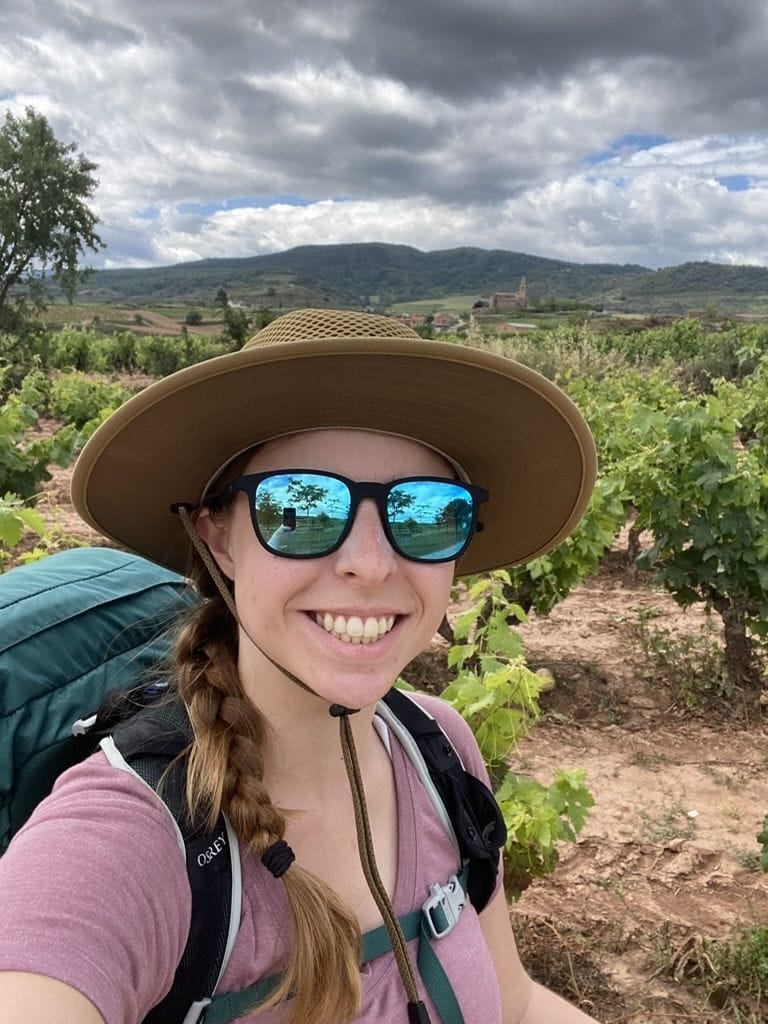
Know That There are No Rules on How You Complete Your Camino
This is YOUR Camino. There's no right or wrong way to hike it. You can be flexible and arrange your plans to fit your needs.
You can start at any point along a route that you wish. You can also spend as much time completing it as you need.
You can theoretically spend years hiking one Camino de Santiago route if you'd like. I think you'll have a better experience if you do it all at once, but some people choose to section hike a route.
I met a man from Madrid who would hike as much of the Camino Francés as he could over the span of a week, and then months, or even years, later, he would pick up the trail where he left off.
You can also get creative in how you complete your Camino. You don't have to necessarily hike it all.
I had a friend who wanted to speed up his Camino Francés hike, so he ended up renting a bike and cycling the Meseta instead of walking all of it. Buses are available as well and can be used to skip certain sections if needed.
Determine What Time of Year You Can Hike
As you think through which route to hike, it's important to think about the time of year you're hiking. Certain times of year are better for some routes than others when it comes to the weather and crowds.
For instance, hiking the Camino Francés in June vs. March is a completely different experience.
If You Want a Certificate, Ensure You Complete the Appropriate Distance
When hiking the Camino de Santiago, pilgrims typically carry a passport with them to record where they stop and visit along the way. Once they reach Santiago de Compostela, they show the passport as proof of their journey at the Pilgrim's Office and get a certificate called a Compostela to commemorate their journey.
To get the Compostela certificate, pilgrims who are journeying on foot or by horse must complete 100 km of their route leading into Santiago de Compostela. Bikers must complete 200 km. The Pilgrim's Office provides more information on the requirements here.
Know That There are Ways to Avoid Crowds
If you're worried about crowds on your Camino de Santiago, don't let that necessarily stop you from choosing a route that you're otherwise interested in hiking. There are ways to avoid crowds, even on the most popular routes during busy times of year, such as:
- Staying “off stage,” which means staying in towns that aren't recommended as stops in the guidebooks. Fewer pilgrims typically stay in these towns, and it makes it easier to avoid crowds. I did this in June past Sarria on the Camino Francés, and it helped so much.
- Starting early each morning. The earlier you start your hikes each morning, the less likely you are to encounter crowds during your hike.

Ultimately, Pick the Experience That Has Most of What You're Looking For
If you're looking for a social experience on the Camino, pick the Camino Francés. If you're hoping for something more solitary, consider the Camino del Norte for a longer route or the Camino Inglés for a shorter route. For something in between, try the Primitivo.
If you feel strongly about mountain or coastal views or Spain vs. Portugal, take that into consideration.
Ultimately, choose the experience that you think best lines up with what you're looking for and go for it! Each trail has it's pros and cons. You can have a special experience on any of them.

Frequently Asked Questions
Here are some answers to frequently asked questions as you consider which Camino route is right for you.
Which Camino route for beginners?
Beginners should consider the Camino Francés. The route is well marked and has access to plenty of accommodation and food options. It's also a popular route with a strong communal feel and provides the quintessential Camino experience.
Either route on the Camino Portugués is good for beginners as well. The Portuguese routes are flatter than the Francés and have a pretty good infrastructure.
What is the most beautiful Camino route?
The most beautiful Camino route is a toss up between the Camino del Norte and the Camino Primitivo. The Camino del Norte offers views of mountains and the ocean, whereas the Camino Primitivo goes deeper into the mountains.
Both routes run through Asturias, which many consider the most beautiful part of Spain. The good news is, if you're torn between the routes, it's easy to hike both–many pilgrims leave the Camino del Norte at Gijón, Spain and switch to the Camino Primitivo in the nearby city of Oviedo, Spain.
How many Camino de Santiago routes are there?
There technically over 200 Camino de Santiago routes. However, 98% of pilgrims complete one of these seven routes: Camino Francés, Camino Portugués Central, Camino Portugués Coastal, Camino Inglés, Camino Primitivo, Camino del Norte, and Vía de la Plata.
How long does it take to walk the Camino de Santiago?
It can take as few as 4 days to as many as 50 days or longer to complete the Camino de Santiago. It depends on which route you decide to do and where you start.
I even met people who had started their hikes from their homes in Germany and Denmark, just like pilgrims before them in the Middle Ages. It took them months to complete their Caminos.
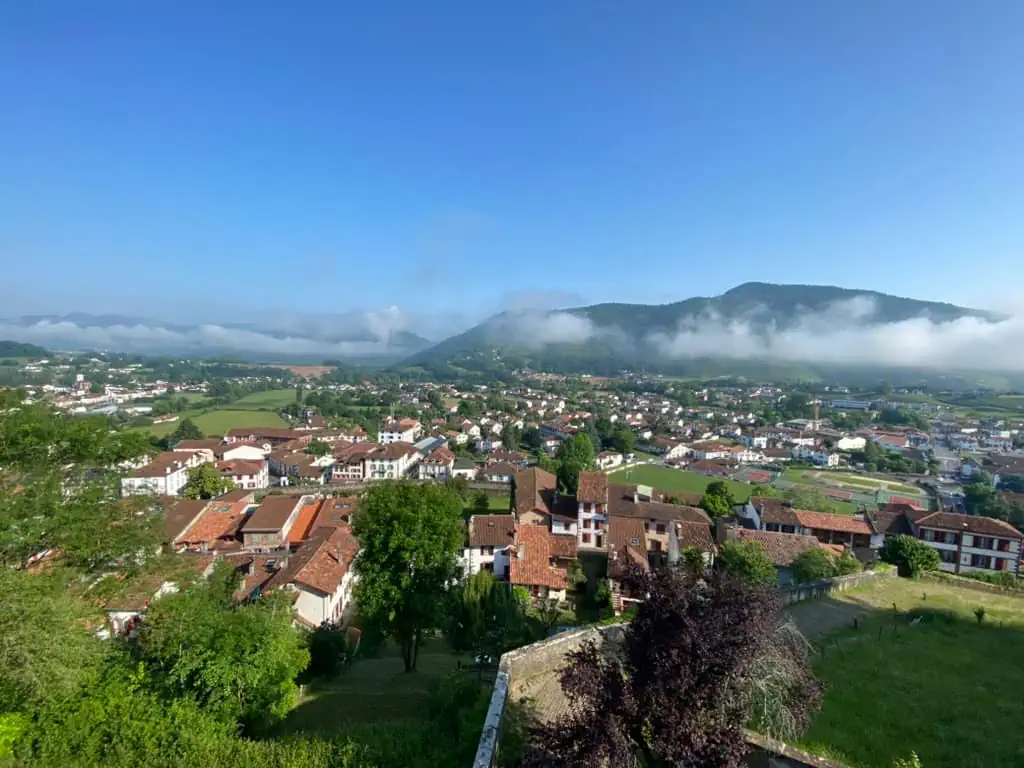
Most Popular Camino de Santiago Starting Points
As you can see, there is no shortage of Camino de Santiago routes to choose from. Fortunately, each route has something unique to offer, so I hope that makes it just a little bit easier as you're planning.
As you consider which route to choose, it can help to think about where you might start. Read next about the most popular places to start the Camino.
